By: Rukhsar Jabbar. M.Sc. Physiotherapy. Freelance Health Writer. Medical review by The DLHA Team
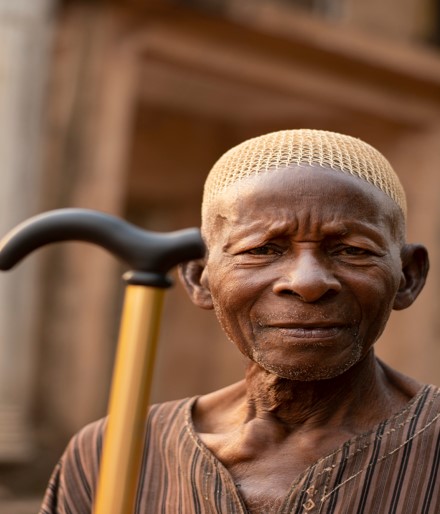
An elderly African man holding a cane. Image credit: Freepik
According to estimates by the World Health Organization (WHO), around 15% of the global population - over one billion people - live with a disability. Of these individuals, 80% reside in low- and middle-income countries (LMICs). [1]
As people age, or suffer a stroke, their risk and fear of falling and getting injured increase. So does their risk of isolation and poor activities of daily living due to poor vision, hearing, memory, muscle and bone strength.
While isolation in the elderly is linked with depression, falls are associated with higher rates of illness, death, decreased overall functioning, and early admission to long-term care facilities. These are why efforts should not be spared in preventing falls, aiding social engagements and activities of daily living in the elderly through the use of assistive products.
But what are assistive products?
According to the World Health Organization (WHO), assistive products, also referred to as assistive devices or technology “enable people to live healthy, productive, independent and dignified lives, and to participate in education, the labour market and civic life”. [2] Some examples of assistive products include mobility enhancing products like canes, crutches, walkers and wheel chairs; hearing aids, spectacles, prostheses, and devices that support memory, among many others.
By promoting independence and the ability to perform daily tasks, the right assistive technology can help individuals maintain their functional abilities, improve their quality of life, reduce cost of engaging carers and secondary health consequences. These benefits in turn, can positively impact the mental health and social interactions of the elderly as well as community development and economic growth.
However, it's important to note that while assistive devices are extremely beneficial to the elderly, as in for example reducing the risk of falls, improper use can actually increase that risk. Therefore, before prescribing any assistive product to the elderly, factors such as their health status, mental and decision making (cognitive) function, specific disabilities and care goals, functional limitations, home environment, and financial situation should be carefully considered. [3]
The aim of the article is to -
Varieties of canes. Click on image to enlarge
The least stable but also the least limiting type of assistive technology is the cane. Using a cane requires adequate balance, upper body strength, and dexterity. Canes can improve walking and standing tolerance by partially off-loading a weak or sore limb, strengthening the base of support, and enhancing sensory feedback from the ground. When used correctly, canes can relieve about 10% of the weight from an injured lower limb.
Canes come in different designs as follows:
To use a cane properly, it should be held on the opposite side of the weak or painful lower limb, and the impaired limb should be advanced simultaneously with the cane. Many canes can be adjusted for the patient's height. Studies have shown that canes boost patients' self-reported functional capacity and confidence. A cane is ideal when assistance with balance or weight-bearing requires only one upper limb. If assistance with both upper limbs is needed, crutches or a walker are more suitable. [3]
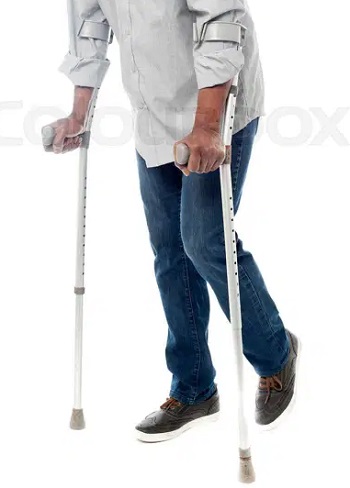
A black man on forearm crutches
Crutches have numerous points of touch (the axilla and hand) with the body, whereas a cane only has one point of contact (the hand). For individuals who need more weight off-loading than canes can offer, crutches can be useful.
Crutches are of different types:
Most bilateral crutches may be adjusted for the height of the patient and can remove 80% to 100% of the weight from a lower limb. But crutches need both hands and adequate upper body strength, stability, and range of motion. Additionally, using crutches raises metabolic demands. For these reasons, older folks seldom ever need crutches. [3]
Varieties of walkers. Click on image to enlarge.
For individuals who are unable to always carry their entire weight on their legs due to poor balance or bilateral lower limb impairment, walkers offer a wide base of support. The majority of walkers feature four height-adjustable legs. When used improperly, walkers can cause poor spine mechanics, be challenging to manoeuvre, and need upper-body strength and the capacity to support at least some of one's body weight. [3] The two main types of walkers available are:
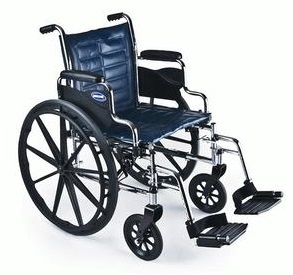
A manual wheelchair
The elderly or stroke patients who lack the lower limb strength, endurance, or balance necessary for walking should be evaluated for wheelchairs. Mobility and quality of life can be enhanced by wheelchairs, but in order to prevent damage to bony prominences and skin breakdown from seat pressure, correct sizing and patient education are necessary. People should have the wheelchair that best suits their functional ability. [3]
Related: Fall Prevention in Elderly Africans
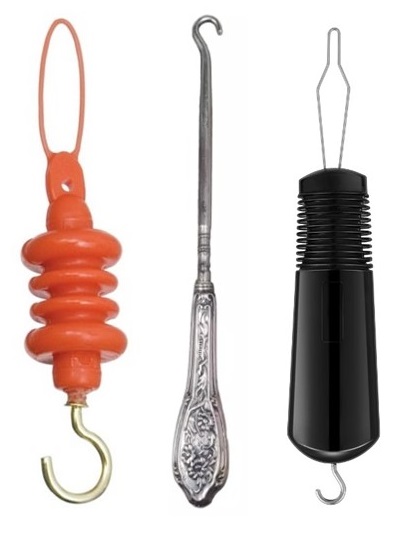
Varieties of buttonhooks
The elderly, stroke survivors and people with arthritis in the hands who have weakness or reduced fine movement of the hands, or issues with two hands coordination may have difficulty performing daily tasks like zipping and unzipping, buttoning and unbuttoning clothing items such as shirts, dresses, gloves, cuffs, collars, shoes, and boots. A devise called the “buttonhook” has been designed to assist with such tasks. [4] The button hook is a device with a hook (or loop-like hook) at one end and a handle at the other. Some have another hook attached to the other end of the handle. This is the zipper hook. There are many varieties of buttonhooks in the market (see illustration below).
To use the button hook, you will;
Watch the video to see how to use a buttonhook
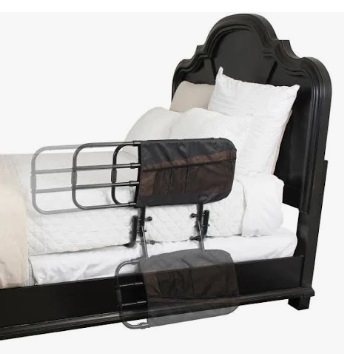
Adjustable bedrails for seniors at home
As people age, bed rails can offer an extra degree of security and comfort. Bed railings lower the danger of falls and offer assistance for safely getting in and out of bed, allowing seniors to preserve their independence in a safe setting. [5] Seniors or the elderly who use bed railings have several benefits beyond just greater safety.
These benefits include-
Sample toilet aids. Click on image to enlarge
Toileting is a basic daily activity essential for everyone, making it relevant to all individuals. Disability however might have a significant impact on one's capacity to do the toileting movement. [6]
Disposable toilet seats can lessen the strain and difficulty of this activity. This handy toilet aid, which is made for the elderly and other people who have trouble bending, turning, and reaching, promotes independence and self-assurance while upholding a high standard of personal hygiene.
The long-handled toilet assist holds tissue or wipes securely for easy wiping, making it ideal for older people with limited mobility. This toileting aid tool's curved form allows it to be used from the front to prevent bending the body, which can hurt or injure people. [7]
.jpg)
Varieties of taking type medical and fall alert devices
Technology devices help improve the lives of senior citizens, allowing them to live independently at home longer. One common technology is personal emergency response systems (PERS), which are used as fall and medical emergency alert systems.
With alert devices, the conscious elderly person can press a help button to connect to a response center or a designated family member at any time. The response contact can then contact emergency services (like an ambulance, police, or fire department) or a nearby helper (like a neighbor) and follow up to ensure help has arrived.
Some alert systems can automatically detect falls or other types of medical emergency like a heart-related event and dial a call centre directly for assistance.
Alert devices are used globally and have been shown to improve quality of life by reducing the fear of falling and increasing confidence in daily activities. Most users find the system easy to use and require little to no training. However, it is found that not all users are willing to use the technology or find it useful. [8]
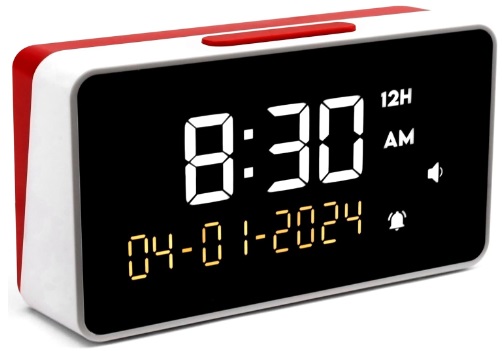
Talking reminder clock.
The World Health Organization (WHO) highlights that poor long-term therapy adherence is a major global issue. In wealthy countries, the average adherence rate is 50%, while it is even lower in underdeveloped nations.
A talking device with a built-in alarm clock, helps senior citizens manage and monitor their monthly medication intake in an easy and efficient way. It also helps medical professionals check if patients are taking their medications as prescribed.
It provides clear, simple instructions for elderly people who may not be familiar with modern technology. It requires little physical effort and minimal understanding of electronic devices. Using it can significantly improve medication adherence in older adults who sometimes forget to take their medications or have difficulties opening packs, reading labels, or understanding instructions from healthcare providers. [9]
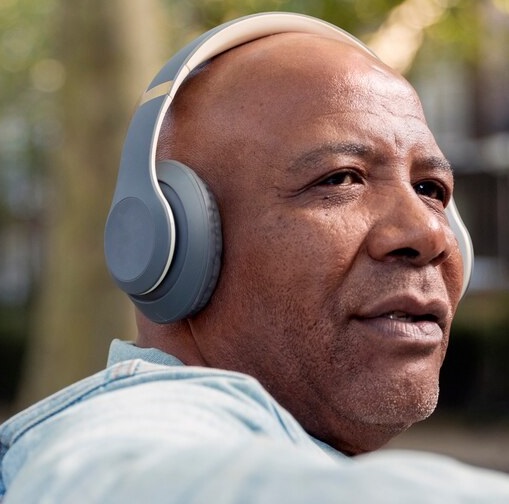
Black senior man wearing wireless headphone. Image credit: Freepik
An estimated 466 million people worldwide suffer from hearing loss, making it one of the most common health issues globally. The primary clinical treatment for age related hearing loss is the use of hearing aids, which significantly improve the wearer's quality of life and listening. [10]
Hearing aids for the elderly are of different types and sophistication. Some come as wireless headphone that can be synched with a home smart TV for proper hearing while watching the TV. Others may have attached neck loops with microphones or wireless earbuds for two way communication via a smartphone.
However, most adults who could benefit from hearing aids cannot afford them or choose not to use them. This is particularly concerning as elderly individuals might need medical attention without the usual support from their families and may struggle to communicate with healthcare professionals or their caregivers.
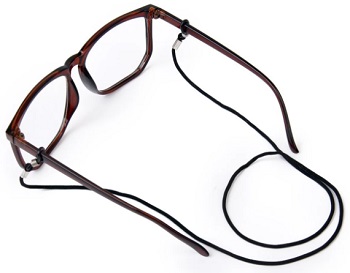
Eye glasses with neck string
Many elderly people worldwide and more so in low resource countries, suffer from vision loss due to refractive errors, cataract, glaucoma, etc. This affects their ability to read, and see well while walking about in or outside their homes. Visual disability affects the quality of life of the elderly and their mental health too. In most cases, a basic prescription eye glass (with or without neck string) may be all that is needed to improve vision. In others, more may need to be done, like the use of liquid eye medications and surgery for cataract removal or for glaucoma.
Portable manual "sitnstand" chair lift. Click on image to enlarge.
For older people to live independently and maintain a good quality of life, they must be able to perform sit-to-stand (STS) and back-to-sit (BTS) movements. Standing up requires lower limb muscle strength and joint flexibility than walking or climbing stairs.
Older adults often struggle with these movements due to decreased muscle strength, stroke, Parkinson's disease, and other conditions that affect balance. Additionally, elderly individuals who cannot stand up on their own tend to have a lower quality of life and a higher risk of falling. [11] Chair lifts aid better quality of life in seniors.
1. World Bank; World Health Organization. The World Report on Disability. [Internet]. 2021 Dec. 14. Cited August 13, 2024. Available from here.
2. World Health Organization (WHO). Assistive Technology. [Internet, n.d.] Cited August 12, 2024. Available from here.
3. Sehgal M, Jacobs J, Biggs WS. Mobility assistive device use in older adults. A. Fam. Physician. 2021, 103(12):737–44. Available from here.
4. Blodgett DE. A fascinating fastener: The button hook - An essential tool. The Chronicle of the Early American Industries Association, Inc; Delmar. 2016, 69(3): 89-101. Available from here.
5. Baiera V. Bed rails for seniors: The benefits of increased safety & comfort. Step2Health [Internet]. 2023 June 14. [Cited 2024 Jul 24]. Available from here.
6. Clark J, Rugg S. The importance of independence in toileting: the views of stroke survivors and their occupational therapists. British Journal of Occupational Therapy [Internet]. 2005, 68(4):165–71. doi: 10.1177/030802260506800404. Available from here.
7. Access Rehabilitation Equipment. What are the top 10 toilet aids for elderly? [Internet] 2023 Sep. 17. [Cited 2024 Jul 23]. Available from here.
8. Agboola S, Golas S, Fischer N, Nikolova-Simons M, Op den Buijs J, Schertzer L, Kvedar J, Jethwani K. Healthcare utilization in older patients using personal emergency response systems: an analysis of electronic health records and medical alert data : Brief Description: A Longitudinal Retrospective Analyses of healthcare utilization rates in older patients using Personal Emergency Response Systems from 2011 to 2015. BMC Health Serv Res. 2017 Apr 18;17(1):282. doi: 10.1186/s12913-017-2196-1. Available from here.
9. Vieira LB, Reis AMM, Ramos CÁ, Reis TMD, Cassiani SHB. The use of an electronic medication organizer device with alarm to improve medication adherence of older adults with hypertension. Einstein (Sao Paulo). 2021 Sep 24;19:eAO6011. doi: 10.31744/einstein_journal/2021AO6011. Available from here.
10. Maidment DW, Amlani AM. Argumentum ad Ignorantiam: Smartphone-Connected Listening Devices. Semin Hear. 2020 Nov; 41(4):254-265. doi: 10.1055/s-0040-1718711. Available from here.
11. Lou SZ, You JY, Tsai YC, Chen YC. Effects of Different Assistive Seats on Ability of Elderly in Sit-To-Stand and Back-To-Sit Movements. Healthcare (Basel). 2021 Apr 20;9(4):485. doi: 10.3390/healthcare9040485. Available from here.
Published: August 14, 2024
© 2024. Datelinehealth Africa Inc. All rights reserved.
Permission is given to copy, use and share content for non-commercial purposes without alteration or modification and subject to source attribution.
DATELINEHEALTH AFRICA INC., is a digital publisher for informational and educational purposes and does not offer personal medical care and advice. If you have a medical problem needing routine or emergency attention, call your doctor or local emergency services immediately, or visit the nearest emergency room or the nearest hospital. You should consult your professional healthcare provider before starting any nutrition, diet, exercise, fitness, medical or wellness program mentioned or referenced in the DatelinehealthAfrica website. Click here for more disclaimer notice.